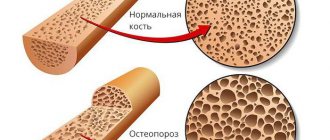Release form and composition
Complivit Calcium D3 Forte is available in the form of chewable tablets with mint or orange flavor, having a biconvex, round shape and a rough surface of white or almost white color, sometimes with grayish inclusions (30, 60, 90, 100 or 120 pieces in polymer jars, covered with a heat-shrinkable cap; one can in a cardboard pack).
Composition per 1 tablet:
- active ingredients: calcium (in the form of calcium carbonate) – 500 mg, vitamin D3 (in the form of granulate) – 0.01 mg (400 IU);
- granulate composition: D,L-alpha-tocopherol, colecalciferol, acacia gum, sucrose, medium-chain triglycerides, calcium phosphate, corn starch, purified water;
- additional components of the tablet: aspartame, polysorbate-80, citric acid, povidone, potato starch, croscarmellose sodium, magnesium stearate, milk sugar, orange flavor or peppermint leaf oil.
Pharmacological properties
Pharmacodynamics
The drug is a combination drug that regulates the exchange of phosphorus and calcium in muscle tissue, bones, nails, teeth and hair. Complivit Calcium D3 Forte reduces resorption and increases bone mineral density. Under its influence, the reabsorption of phosphates in the kidneys and the absorption of calcium in the intestines, as well as the process of mineralization of teeth and bones, are enhanced.
Calcium, as a separate component, is necessary for the normal functioning of the cardiovascular system. It is involved in the formation of hormones, regulation of muscle contractions and conduction of nerve impulses. This macroelement is one of the most important components of the blood coagulation system. The need for calcium especially increases in children during the period of active growth, as well as in women carrying a child and breastfeeding.
Colecalciferol (vitamin D3) promotes better calcium absorption in the small intestine and is involved in the formation and mineralization of dental and bone tissue.
The combined effect of calcium and vitamin D3 is expressed in slowing down the production of parathyroid hormone, which stimulates increased leaching of calcium from the bones.
Pharmacokinetics
Colecalciferol is absorbed in the small intestine (about 80% of the dose taken is absorbed). Vitamin D3 and its metabolites bind to specific globulin and circulate in the blood in this form. In the liver, colecalciferol is metabolized to 25-hydroxycalciferol, from which 1,25-hydroxycalciferol is subsequently formed (by metabolism in the kidneys). This is the active form of vitamin D3, which causes increased calcium absorption. In unmetabolized form, vitamin D3 is stored in muscle and fat tissue. Excretion is carried out by the kidneys and through the intestines.
Calcium is absorbed in the proximal small intestine. The absorption mechanism is active, D-vitamin dependent. About 30% of the calcium dose taken is absorbed. Almost 99% of calcium intake is found in the hard structure of teeth and bones. About 1% is found in liquids. Half of all calcium circulating in the blood is in ionized (active) form, of which approximately 40% of free calcium is bound to plasma proteins and 10% to various anions. Calcium is excreted by the sweat glands, kidneys and intestines.
pharmachologic effect
A combined drug whose effect is determined by its constituent components. Regulates the exchange of calcium and phosphates, reduces resorption and increases bone density, replenishes the lack of calcium and vitamin D3 in the body, enhances the absorption of calcium in the intestines and the reabsorption of phosphates in the kidneys, promotes bone mineralization.
Calcium – is involved in the formation of bone tissue, blood clotting, maintaining stable cardiac activity, and in carrying out the processes of transmission of nerve impulses.
Vitamin D3 (colecalciferol) – promotes the absorption of calcium in the intestines, the formation and mineralization of bone and dental tissue.
The use of calcium and vitamin D3 prevents an increase in the production of parathyroid hormone, which is a stimulator of increased bone resorption.
Contraindications
According to the instructions, Complivit Calcium D3 Forte is contraindicated in patients with severe renal failure, kidney stones, active tuberculosis, decalcifying tumors (myeloma, sarcoidosis and bone metastases).
The drug is also not used for hypervitaminosis D, high concentrations of calcium in the blood and urine, in children under 3 years of age and in persons with hypersensitivity to individual components.
Due to the sucrose content of the tablets, they are contraindicated in people with lactose intolerance, lactase or isomaltase/sucrase deficiency and glucose-galactose malabsorption. The drug should not be used in patients with phenylketonuria, since the tablets contain aspartame.
Complivit Calcium D3 Forte is prescribed with caution to pregnant and lactating women and persons with mild or moderate renal failure.
Complivit Calcium D3 Forte, instructions for use (method and dosage)
Chewable tablets are intended for oral use. They should be chewed or dissolved, washed down with water if necessary. The drug is taken with food.
For the treatment of osteoporosis, adults are prescribed one tablet of Complivit Calcium D3 Forte two to three times a day. In order to prevent osteoporosis, the drug is taken two tablets per day (in 2 divided doses, one tablet or once the entire daily dose).
If there is a lack of calcium or vitamin D3, adults and children over 12 years of age are prescribed two Complivit Calcium D3 Forte tablets per day. Children aged 3 to 12 years are usually given one tablet per day.
For elderly patients and those with impaired liver function, the dose is not reduced, but the possible decrease in creatinine clearance in people over 65 years of age should be taken into account.
The duration of the course of treatment and prevention of osteoporosis is determined individually. In case of calcium or vitamin D3 deficiency, as well as for the purpose of preventing these conditions, the duration of taking Complivit Calcium D3 Forte is 4–6 weeks. Repeated courses are possible as prescribed by a doctor.
Reception scheme
It is recommended to drink the supplement for one month, several times a year. But you need to know how to take Complivit Calcium D3 Forte tablets.
They can be chewed during meals and washed down with water. Dosage depends on age and indications. For preventive purposes, the following daily doses are recommended:
- children 3-12 years old should take 1 piece;
- adults - 1-2 pcs.
For medicinal purposes, the frequency of administration is increased to 2-3 times a day.
Note! The daily dose for women carrying a child and breastfeeding is determined by the doctor.
Overdose
Calcium overdose is manifested by the following symptoms: nausea, thirst, vomiting, anorexia, abdominal pain, constipation, urolithiasis, increased urination, kidney calcification, headache, mental disorders, dizziness, fainting, fatigue, coma, arrhythmias (in severe cases) , kidney damage and soft tissue calcification (with long-term high-dose therapy).
If the patient shows signs of calcium overdose, treatment with the drug should be stopped and seek help from a doctor. In addition, cardiac glycosides and thiazide diuretics should be discontinued (if they were used simultaneously with Complivit Calcium D3 Forte).
The patient is prescribed calcitonin, glucocorticosteroids, loop diuretics and bisphosphonates. Adequate drinking regime is ensured. Hemodialysis is possible. In particularly severe situations, monitoring of central venous pressure and an electrocardiogram (ECG) are required.
Overdose of Calcium-D3 nycomed forte, symptoms and treatment
The most serious consequence of acute or chronic overdose of the drug is hypercalcemia caused by hypersensitivity to vitamin D. A toxic effect is possible if 200 chewable tablets are taken per day. Symptoms of hypercalcemia include anorexia, nausea, vomiting, dizziness, weakness, headache, hypercalciuria, hypercreatinemia. Coma may develop. The presence of polydipsia and polyuria indicates the possibility of kidney damage. Treatment. Taking the pills should be stopped, a large amount of fluid should be introduced into the body and a diet with a limited calcium content should be prescribed. In especially severe cases, it may be necessary to use GCS and other symptomatic therapy.
special instructions
Long-term therapy with Complivit Calcium D3 Forte should be carried out with caution, regularly measuring serum creatinine and calcium levels. Elderly patients taking diuretics or cardiac glycosides together with calcium, and patients with a tendency to urolithiasis should be under special supervision. If symptoms of hypercalcemia or renal failure occur, reduce the dose of the drug or completely stop treatment.
Colecalciferol is prescribed with caution to persons with insufficient renal function. In such patients, serum phosphate and calcium levels should be additionally monitored, and other sources of colecalciferol intake (for example, food) should be considered.
Daily requirements for elderly people:
- calcium – 1500 mg;
- vitamin D3 – 500–1000 IU.
In patients with osteoporosis and low mobility, there is a high risk of developing hypercalcemia; the drug is prescribed to such patients with caution.
Impact on the ability to drive vehicles and complex mechanisms
Complivit Calcium D3 Forte does not affect the ability to drive motor vehicles and other vehicles and engage in other potentially dangerous activities associated with high concentration and the need for quick reaction.
Use during pregnancy and lactation
During pregnancy, Complivit Calcium D3 Forte can be used for calcium and colecalciferol deficiency, but the daily dose should not exceed one tablet (to avoid hypercalcemia, potentially dangerous to the fetus).
Breastfeeding is not a contraindication to the use of the drug, but the recommended daily requirements for vitamin D3 and calcium should not be exceeded. It is also necessary to take into account other sources of these substances entering the body of both the mother and the child.
Drug interactions
During treatment with the drug, possible interactions of calcium and vitamin D3 with other medications and drugs should be taken into account:
- loop diuretics – increase the excretion of calcium in the urine;
- thiazide diuretics – inhibit the excretion of calcium by the kidneys and increase the risk of developing hypercalcemia;
- glucocorticosteroid drugs – reduce calcium absorption (dose adjustment required);
- quinolone and tetracycline antibiotics - their absorption may be reduced (it is necessary to maintain an interval of 2 to 4-6 hours between taking calcium supplements and the listed antibiotics);
- cardiac glycosides - possible potentiation of the toxic effects of cardiac glycosides (especially in the case of hypercalcemia);
- barbiturates, phenytoin - can reduce the activity of vitamin D3;
- bisphosphonates – Complivit Calcium D3 Forte reduces the absorption of bisphosphonates (an interval of at least 1 hour between taking these drugs is required);
- oxalates, phytin – reduce calcium absorption (products containing oxalates or phytin should be consumed separately from calcium);
- cholestyramine, laxatives based on vegetable or mineral oil - may reduce the absorption of colecalciferol;
- levothyroxine - the drug reduces the effectiveness of levothyroxine (the interval between taking these drugs should be at least 4 hours).
Interactions of the drug Calcium-D3 nycomed forte
Calcium can enhance the absorption of tetracycline drugs in the gastrointestinal tract, therefore the interval between taking tetracycline drugs and Calcium-D3 N icomed Forte should be at least 3 hours. To prevent a decrease in the absorption of bisphosphonates or sodium fluoride, it is recommended to take Calcium-D3 N icomed Forte no earlier than 2 hours after taking them. Vitamin D3 activity may be decreased with concomitant use of phenytoin or barbiturates. During simultaneous treatment with cardiac glycosides, it is necessary to monitor the ECG and the clinical condition of the patient, since calcium preparations can potentiate the therapeutic and toxic effects of cardiac glycosides. GCS reduce calcium absorption, therefore, when carrying out systemic therapy with GCS, it may be necessary to increase the dose of Calcium-D3 Nycomed Forte. Concomitant treatment with cholestyramine or taking laxatives based on mineral or vegetable oil may reduce the absorption of vitamin D. With simultaneous use of thiazide diuretics, the risk of hypercalcemia increases, since thiazide diuretics increase the tubular reabsorption of calcium. Furosemide and other loop diuretics, on the contrary, increase calcium excretion by the kidneys.
Reviews of Complivit Calcium D3 Forte
The drug has earned the trust of users, so it is recommended by almost all patients who left reviews about Complivit Calcium D3 Forte on various websites and forums on the Internet. Taking the drug quickly replenishes calcium deficiency. The drug prevents the development of osteoporosis, improves the appearance of nails and hair, and strengthens teeth. Pregnant women also respond well to this dosage form of calcium and vitamin D3 (eliminates cramps, replenishes calcium deficiency after childbirth). In addition, Complivit Calcium D3 Forte is inexpensive, and the tablets are packaged in a convenient jar.
Some patients consider the disadvantages of the drug to be the large size of the tablets, their specific taste, as well as the side effects (not suitable for everyone).
Reviews, advantages and disadvantages
Leave feedback about the supplement Complivit Calcium D3 Forte. Write what pros and cons you found:
| Leave feedback | |
| 1 2 3 4 5 | |
| Send Cancel | |
Send your review
Complivit calcium D3 forte
Average rating: Number of reviews: 0
Pros:
- the active ingredients are well absorbed;
- nails grow faster and don’t peel off;
- hair condition improves;
- teeth do not crumble during pregnancy;
- leg cramps disappear;
- the tablets have a pleasant taste;
- the drug is inexpensive.
Minuses:
- the tablets are large, making them difficult to swallow;
- there are side effects.







